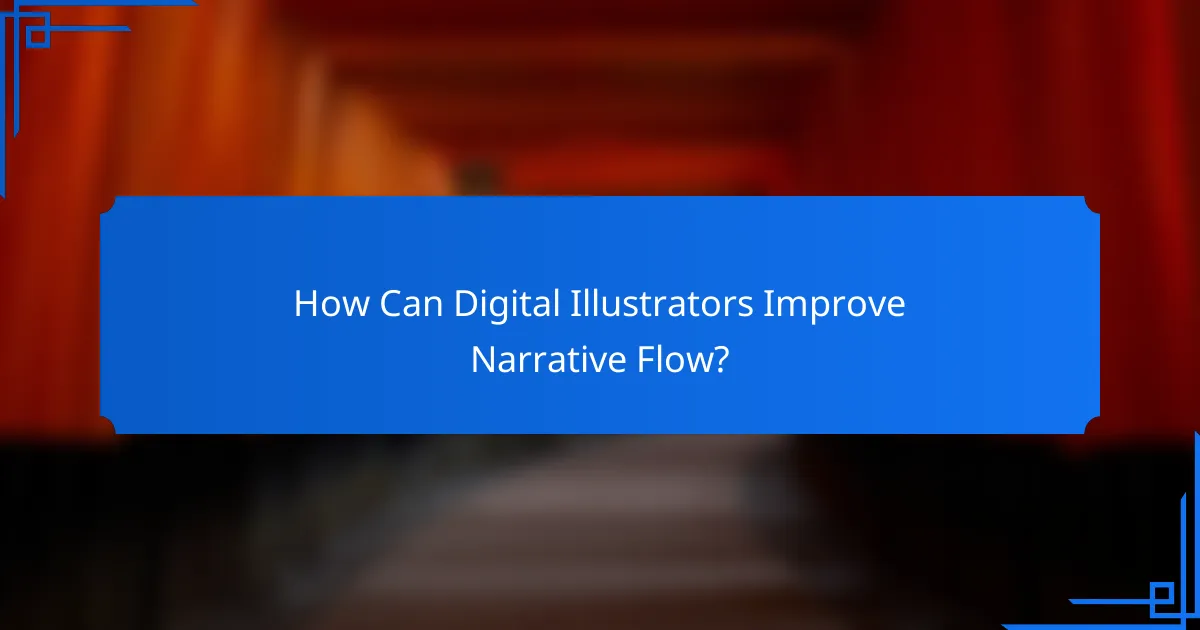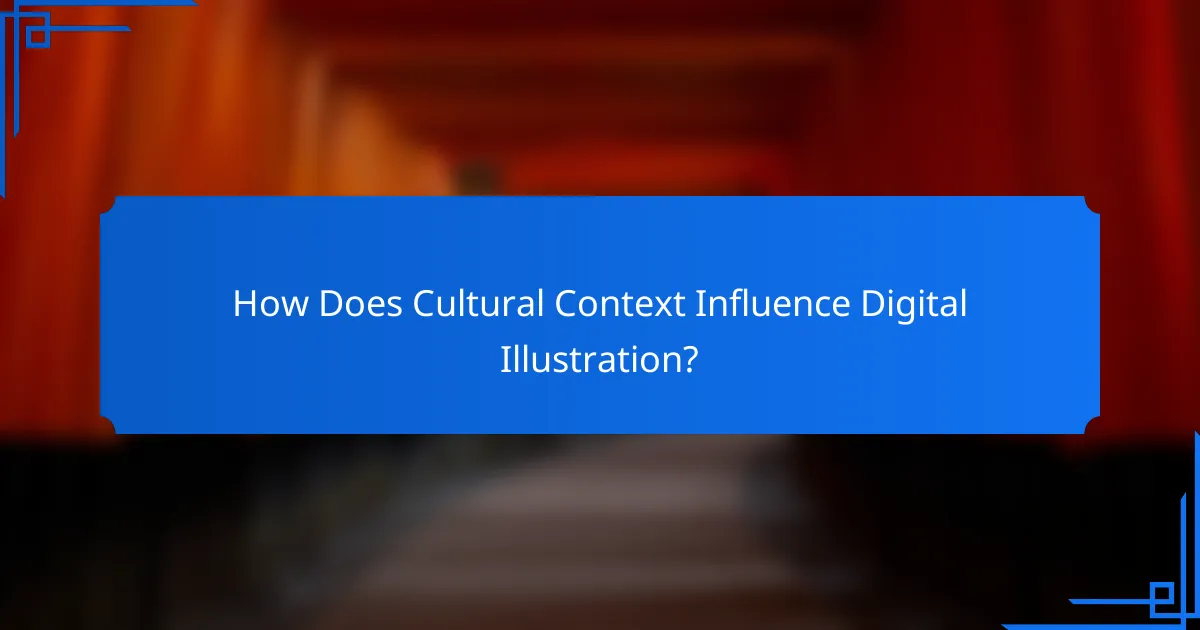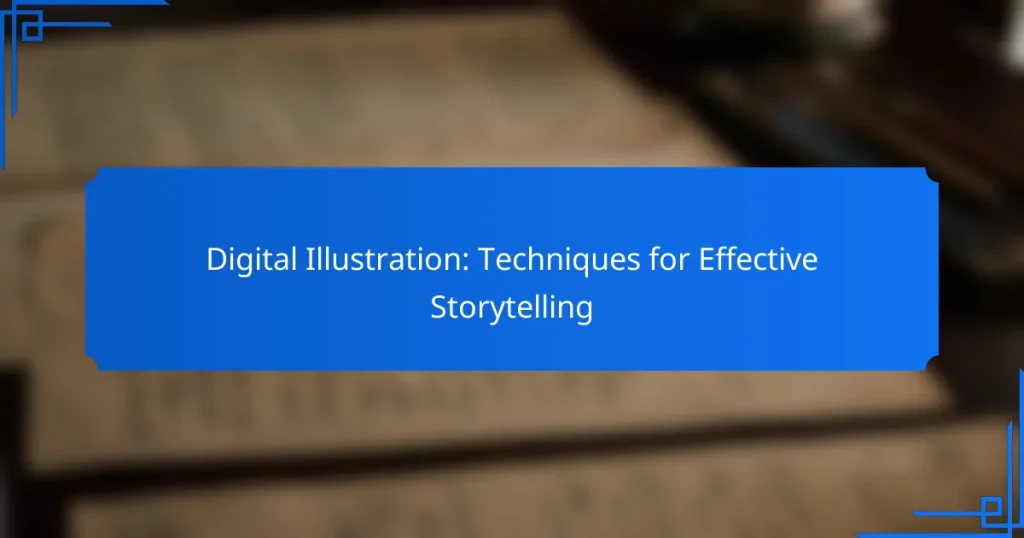Digital illustration serves as a powerful medium for storytelling, utilizing various techniques to engage viewers and communicate narratives effectively. By mastering elements such as character design, color theory, and composition, artists can create compelling visuals that guide the audience through the story. Tools like Adobe Illustrator and Procreate further enhance these techniques, allowing for a diverse range of styles and approaches in visual storytelling.

What Techniques Enhance Digital Illustration for Storytelling?
Effective storytelling in digital illustration relies on techniques that engage viewers and convey narratives clearly. Key methods include character design, color theory, composition, visual metaphors, and lighting effects, each contributing uniquely to the overall impact of the artwork.
Character Design
Character design is crucial for storytelling as it establishes personality and relatability. A well-designed character should reflect their role in the narrative through visual traits like clothing, facial expressions, and body language. For instance, a hero might have bold colors and strong postures, while a villain could use darker tones and menacing angles.
Consider creating a character sheet that includes various poses and expressions to ensure consistency and depth. This helps in maintaining the character’s identity throughout the story, making them memorable to the audience.
Color Theory
Color theory plays a significant role in evoking emotions and setting the mood of a story. Different colors can symbolize various themes; for example, blue often conveys calmness, while red can indicate danger or passion. Choosing a color palette that aligns with the story’s tone enhances the viewer’s emotional connection.
When selecting colors, consider using a limited palette to create harmony or contrasting colors to highlight important elements. Tools like Adobe Color can assist in generating effective color schemes that complement your narrative.
Composition
Composition refers to the arrangement of visual elements within an illustration, guiding the viewer’s eye and emphasizing key aspects of the story. A balanced composition can create a sense of stability, while an asymmetrical layout can add tension and interest. Techniques such as the rule of thirds can help in positioning focal points effectively.
Experiment with different compositions to see how they affect storytelling. For example, placing a character off-center can create a dynamic scene, while a centered composition might convey order and clarity.
Visual Metaphors
Visual metaphors are powerful tools in digital illustration that convey deeper meanings through imagery. They allow artists to represent complex ideas simply and effectively. For instance, illustrating a character surrounded by storm clouds can symbolize inner turmoil or conflict.
When using visual metaphors, ensure they are clear and relevant to the narrative. Avoid overcomplicating the imagery, as this can confuse the viewer rather than enhance understanding.
Lighting Effects
Lighting effects significantly influence the mood and atmosphere of an illustration. Proper use of light and shadow can create depth and draw attention to specific areas, enhancing storytelling. For example, dramatic lighting can heighten tension during a climactic moment, while soft lighting can evoke a sense of peace.
Experiment with different light sources and angles to see how they change the perception of your illustration. Consider using tools like layers in digital software to manipulate lighting effects easily, allowing for greater control over the final look.

How Can Digital Illustrators Improve Narrative Flow?
Digital illustrators can enhance narrative flow by using techniques that guide the viewer’s eye and convey the story effectively. Key methods include sequential art, thoughtful panel layouts, and comprehensive storyboarding.
Sequential Art
Sequential art involves arranging images in a specific order to tell a story, allowing viewers to follow the narrative visually. This technique can be applied in comics, graphic novels, and animations, where each frame builds upon the last to create a cohesive flow.
To improve narrative flow, focus on pacing and transitions between images. Use visual cues like motion lines or changes in perspective to indicate time passing or shifts in action. A common pitfall is overcrowding frames, which can confuse viewers; aim for clarity and simplicity instead.
Panel Layouts
Panel layouts dictate how images and text are organized on a page, influencing how the story is perceived. Effective layouts guide the reader’s eye naturally from one panel to the next, enhancing comprehension and engagement.
Consider using a grid system for consistency, but feel free to break the grid for dramatic effect. Varying panel sizes can emphasize key moments or create tension. Avoid overly complex layouts that might distract from the narrative; simplicity often leads to stronger storytelling.
Storyboarding
Storyboarding is the process of sketching out scenes in sequence to visualize the narrative flow before finalizing illustrations. This technique helps identify pacing, composition, and transitions, ensuring that the story unfolds smoothly.
When storyboarding, focus on key scenes and how they connect. Use thumbnails to quickly explore different compositions and angles. A common mistake is neglecting to plan transitions; ensure that each scene leads logically to the next to maintain viewer engagement.

What Tools Are Essential for Digital Illustration?
Essential tools for digital illustration include software that caters to different styles and techniques, enabling artists to create compelling visuals. Popular choices like Adobe Illustrator, Procreate, and Clip Studio Paint each offer unique features that can enhance storytelling through illustrations.
Adobe Illustrator
Adobe Illustrator is a vector-based design software widely used for creating scalable graphics. Its precision and versatility make it ideal for illustrations that require clean lines and sharp details, such as logos and typography.
When using Illustrator, take advantage of features like the Pen Tool for creating custom shapes and the Layers panel for organizing your artwork. A common pitfall is overcomplicating designs; aim for simplicity to maintain clarity in your storytelling.
Procreate
Procreate is a popular digital painting app designed for the iPad, favored for its intuitive interface and natural brush feel. It allows artists to create detailed illustrations with a wide range of brushes and textures, making it suitable for both beginners and professionals.
To maximize Procreate’s potential, explore its layering capabilities and blending modes. A useful tip is to utilize the QuickMenu for frequently used actions, which can speed up your workflow significantly. Avoid overcrowding your canvas with too many elements, as this can detract from the main narrative.
Clip Studio Paint
Clip Studio Paint is tailored for comic and manga artists, offering specialized tools for inking and panel layout. Its robust features support both raster and vector graphics, making it versatile for various illustration styles.
Key functionalities include customizable brushes and 3D models for reference, which can enhance your storytelling. Be mindful of the learning curve; investing time in tutorials can greatly improve your skills. Remember to regularly save your work, as large files can lead to crashes if not managed properly.

How Do You Choose the Right Style for Your Story?
Choosing the right style for your story involves understanding the emotional tone and visual language that best conveys your narrative. Consider how different styles can enhance or detract from the story’s themes and characters.
Target Audience
Your target audience significantly influences the style you should choose. For example, a children’s book may benefit from bright colors and whimsical designs, while a graphic novel aimed at adults might favor a more muted palette and realistic illustrations.
Understanding the preferences and expectations of your audience can guide your stylistic choices. Conducting surveys or analyzing similar works can provide insights into what resonates with your intended readers.
Genre Considerations
The genre of your story plays a crucial role in determining the appropriate illustration style. Fantasy stories often utilize vibrant, imaginative art, while horror may lean towards darker, more atmospheric visuals.
Consider the conventions of your genre and how they can be reflected in your illustrations. For instance, a romance story might benefit from soft lines and pastel colors, while a thriller could use sharp contrasts and dynamic compositions.
Artistic Influences
Incorporating artistic influences can help define your unique style. Look at the works of established illustrators and artists who inspire you, and analyze how their techniques can be adapted to fit your story.
Experimenting with different artistic movements, such as surrealism or minimalism, can also provide fresh perspectives. Create a mood board with examples of styles that resonate with your narrative to clarify your vision before starting your illustrations.

What Are the Best Practices for Collaborating with Writers?
Effective collaboration between digital illustrators and writers hinges on clear communication, structured feedback, and a shared vision. These practices ensure that both parties align their creative efforts to produce cohesive and compelling narratives.
Clear Communication
Clear communication is vital for successful collaboration. Both illustrators and writers should establish a common language regarding project goals, timelines, and expectations. Regular check-ins can help clarify any misunderstandings early in the process.
Utilizing visual aids, such as mood boards or sketches, can enhance understanding and provide a reference point for discussions. This approach allows both parties to visualize concepts and ensures everyone is on the same page.
Feedback Loops
Implementing feedback loops is essential for refining ideas and improving the final product. Set specific milestones for feedback, allowing both the writer and illustrator to review each other’s work at various stages. This iterative process can lead to more polished outcomes.
Encourage constructive criticism by framing feedback positively. For instance, instead of saying “this doesn’t work,” suggest alternatives that align with the project’s vision. This fosters a collaborative atmosphere and promotes creative growth.
Shared Vision
A shared vision is crucial for cohesive storytelling. Both the writer and illustrator should discuss the overall theme, tone, and style of the project before diving into the details. This alignment helps ensure that the illustrations complement the narrative effectively.
Creating a project brief that outlines the key elements of the story and visual style can serve as a reference throughout the collaboration. This document should be revisited and updated as necessary to reflect any changes in direction or focus.

How Does Cultural Context Influence Digital Illustration?
Cultural context significantly shapes digital illustration by affecting the symbols, colors, and themes used in storytelling. Artists must consider the cultural backgrounds of their audience to create relatable and impactful visuals that resonate with viewers.
Symbolism
Symbolism in digital illustration refers to the use of images and icons that convey deeper meanings rooted in cultural beliefs. Different cultures may interpret symbols uniquely, so understanding these nuances is crucial for effective storytelling.
For instance, a lotus flower symbolizes purity in many Asian cultures, while in Western contexts, it may not carry the same significance. When illustrating, artists should research the cultural meanings behind symbols to avoid misinterpretation and ensure their work communicates the intended message.
To effectively incorporate symbolism, consider using familiar icons that resonate with your target audience. Create a checklist of symbols relevant to the culture you are addressing, and ensure they align with the narrative you wish to convey. This approach enhances the emotional connection and comprehension of your illustrations.


